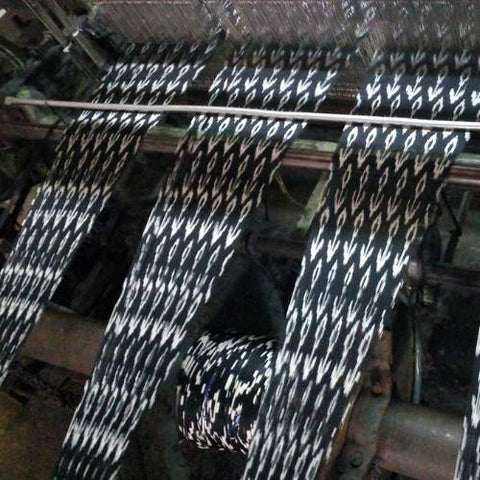8 Steps of Handloom Weaving & Dyeing
On a visit to India in the summer of 2014, I met with a new group of handloom weavers. They lived in a little village that looked like a small plot of land in the middle of nowhere on Google Maps. It was there that I spent a full day absorbing the unique and ancient process of tie and dye, also called ikat fabric, and discovered just how complicated and intricate handloom weaving can be.
With its rich ties to Indian culture and widespread use throughout the country to this day, I set about learning as much as I could about the handloom weaving process and why the clothing it produces is still so valuable today.
Ikat and Resist Dyeing
As dyeing and weaving go hand in hand, let’s take a quick look at the dyeing process.
In India, ikat is a special technique used to create patterns on textiles through the process of resist dyeing. Yarn is first stretched and marked according to the designer’s intended pattern. Then it is tightly wrapped in dye-resistant bindings that will create the chosen pattern and dyed.
If additional colors and patterns are going to be used, the yarn must first be fully dried after its initial dyeing. The bindings can then be changed to create another pattern, and the yarn dyed again in a different color.
This is very similar to today’s tie-dyeing technique. With ikat, however, the dyeing is done on yarn before it has been woven into a fabric. Aside from binding the yarn, other resistance methods, such as wax or a paste, can be used to create the patterns.
Main sources for traditional dyes over the years have included shellac for red, iron shavings for black, and turmeric for yellow. Today, plants and vegetables are often used to create natural dyes.
Our Dyeing and Handloom Weaving Process
The dyeing and handloom weaving process is a source of livelihood and tradition for artisans all over India. These handloom weavers and dyers must have incredible skill and creativity to produce fabrics in a variety of designs and with complete precision. Each finished handloom product is distinct with its own character and pattern.
Today, very few countries still use the handloom weaving process. According to Elle India, India is responsible for producing 95% of the world’s handwoven fabrics. Let’s take a look at the steps involved in this ancient art:
1. First, several rows of yarn are stretched out through the length of a house. This length is approximately 10 meters and will create 24 meters when woven into fabric.
2. After the yarn has been fully stretched out, the handloom weaver draws lines across the yarn, indicating the chosen pattern that will become the final design on the fabric.


5. When the yarn reaches the proper color depth, the bindings are removed. This gives the artisan their first glimpse at the pattern they have created with the dye.

7. If a second or third color is used in the design, then steps 1–6 will be repeated for each color needed. This allows for a great deal of variety, providing designers with endless pattern and color options.
8. Once the yarn is completely dry, and all colors and patterns have been applied, it is then placed on cones on the loom. It takes 32 cones of yarn to make 24 meters of fabric. The handloom weaving process can be complicated, as the weaver has to precisely dye the threads and then place them exactly in the right pattern on the loom so that it is woven correctly.

The design process takes up to 5 hours to complete, while the dyeing and drying process can take another 1–3 days for 24 meters. A handloom weaver takes 16 hours to spin 24 meters manually, or an electric loom can spin 24 meters in about 12 hours. Once the loom has been spun, the 24 meters of fabric are ready!
Types of Looms

There are two main kinds of looms used for handloom weaving today: a manual and an electric. While most of India still uses the manual handloom, many other countries in the world have taken to the electric loom, which works at a quicker pace.
Electric Loom
The electric loom takes about 12 hours to spin 24 meters of fabric. It wasn’t until around the 1850s that the electric loom became widely used with the demand for faster fabric production.
While its speed is beneficial, the electric loom doesn’t give the same amount of freedom and artistry that the traditional handloom still used in India can deliver. It is also less sustainable than a manual loom, which does not require electricity.
Manual Loom
Slightly slower than an electric loom, the manual loom can take up to 16 hours to spin 24 meters. Handloom weaving plays an important role in the Indian economy by providing employment opportunities to artisans and increasing economic development. Because the manual loom does not require electricity to operate, it allows artisans who do not have access to electricity the ability to weave fabrics.
Weaving is a vibrant part of Indian history, and the manual handloom has been a critical part of the process. Its flexibility allows for the introduction of new designs that are often not able to be replicated by the electric loom. The handloom is still widely used in India today to create sustainably handwoven fabrics.
Shop Handloom Woven and Dyed Clothes
At Passion Lilie, we pride ourselves on our traditionally crafted, handwoven clothes. By shopping with us, you can help keep ancient dyeing and handloom weaving traditions alive in India.
We carry a variety of handwoven dresses, skirts, tops, scarves, and more. Browse our full inventory or shop our Indian handwoven clothes today.



Beautiful! very educative.
Leave a comment